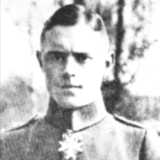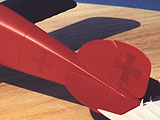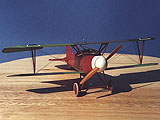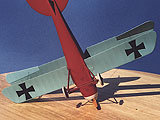Albatros D.III in Allmenröder's markings
Eduard 1/48
By: Tomasz Gronczewski
Karl Allmenröder | the model
| colors | conclusions | the
gallery | links
Karl Allmenröder
|
The man
|

|
When the leader of an outfit is such outstanding ace as
Manfred von Richthofen, other members of the squad can be easily outclassed
by his fame. Nothing similar happened to another Jasta 11's star Karl
Allmenröder.
"Karlchen" Allmenröder was born on May 3rd 1896
in a family of pastor. He started medicine studies but outbreak of the
great war threw him to the artillery. During fighting in Poland against
Imperial Russian army in 1915 he was awarded with Iron Cross and later
with Friedrich August Cross. However in early 1916 he and his brother
Willi decided to climb into skies and started flying course at Fliegerschule
Halberstadt. On March 29 they were assigned to FA227. Being artillery's
workhorses soon became boring for both brothers and in November 1916
they managed to transfer to new Jasta 11. Three months after his arrival
Karl started his long run of victories. His score was growing up steadily.
When "Bloody April" began Allmenröder had been already an
ace, and during this famous month he added four more victories. But
it was in May 1917 when he gained biggest fame. During this month he
downed thirteen RFC's planes - by far more than any other German pilot
in the same time. It was officially recognized on June 6th when he was
awarded with the Knight's Cross of Hohenzollern House Order. A few days
later, on June 14th he gained his own Blue Max. On June 25th 1917 Manfred
von Richthofen became a commander of a new Jagdgeschwader, and it was
Allmenröder who took honor of commanding now famous Jasta 11.
Nobody knew then that Karl's brilliant career was about
to end. On June 27th, a day after he scored his last 30th victory, Karl
Allmenröder met his fate. His Albatros was shot by Allied guns, and
mortally wounded pilot crashed between the trenches.
Despite the fact that war continued and many aces built
up their scores, Allmenröder maintained posthumously his position of
fourth scoring ace of Jasta 11. He is now remembered as one of the most
famous German aces, and one of the few whose almost all victims seem
to be fully identified and confirmed without any disputes.
|
|
|
and the machine
|

|
Allmenröder's D.III was a standard aircraft from mid production
series with a radiator off-set to right. As other high scoring Jasta
11 aces Allmenröder painted fuselage, struts, undercarriage and wheel
discs with red. Nose and elevator carried usually ace's personal color,
which in the case of "Karlchen" was white.
|
Franz Ray’s scoreboard
|
1.
|
Feb 16th 1917
|
B.E.2c (no. 4179 of 16 RFC)
|
S of Roeux
|
Jasta 11
|
|
2.
|
Mar 9th 1917
|
F.E.8 (no. 6339 of 40 RFC)
|
Hulluch
|
Jasta 11
|
|
3.
|
Mar 17th 1917
|
Sop. 1 1/2 Strutter (A1111 of 43 RFC)
|
Oppey
|
Jasta 11
|
|
4.
|
Mar 21st 1917
|
Sop. 1 1/2 Strutter (A2390 of 43 RFC)
|
S Vermelles, Loos
|
Jasta 11
|
|
5.
|
Mar 30th 1917
|
Nieuport 17 (no. 6780 of 40 RFC)
|
Near Bailleul
|
Jasta 11
|
|
6.
|
Apr 2nd 1917
|
B.E.2 (no. 2510 of 13 RFC)
|
SW Lens
|
Jasta 11
|
|
7.
|
Apr 25th 1917
|
R.E.8 (A3213 of 59 RFC)
|
Guemappe
|
Jasta 11
|
|
8.
|
April 26th 1917
|
B.E.2g (A2859 of 16 RFC)
|
Vimy
|
Jasta 11
|
|
9.
|
April 27th 1917
|
B.E.2c (no. 2713 of 2 RFC)
|
Athies-Fampoux
|
Jasta 11
|
|
10.
|
May 7th 1917
|
B.E.2c (no. 4595 of 13 RFC)
|
Fresnoy
|
Jasta 11
|
|
11.
|
May 10th 1917
|
Sop. Pup (A6178 of 66 RFC)
|
Vitry
|
Jasta 11
|
|
12.
|
May 13th 1917
|
R.E.8 (A4245 of 16 RFC)
|
Arleux
|
Jasta 11
|
|
13.
|
May 13th 1917
|
Nieuport 23 (B1567 of 29 RFC)
|
Ostricourt
|
Jasta 11
|
|
14.
|
May 14th 1917
|
B.E.2e (no. 2555 of 8 RFC)
|
Guemappe
|
Jasta 11
|
|
15.
|
May 18th 1917
|
B.E.2e (no. 7074 of 12 RFC)
|
W Monchy
|
Jasta 11
|
|
16.
|
May 19th 1917
|
Sopwith
|
Fosse 8, Bethune
|
Jasta 11
|
|
17.
|
May 24th 1917
|
F.E.2b (A5517 of 11 RFC)
|
Boiry-Notre Dame
|
Jasta 11
|
| 18. |
May 24th 1917 |
Sop. 1 1/2 Strutter (A973 of 43 RFC) |
Izel-Ferme |
Jasta 11 |
| 19. |
May 25th 1917 |
Nieuport 23 (A6778 of 60 RFC) |
Bois du Vert |
Jasta 11 |
| 20. |
May 25th 1917 |
D.H.4 (A7409 of 55 RFC) |
Monchy |
Jasta 11 |
| 21. |
May 28th 1917 |
Ni. Scout (B1575 of 60 RFC Maj Scott) |
Feuchy Tilloy |
Jasta 11 |
| 22. |
May 29th 1917 |
B.E.2 (A4221 of 5 RFC) |
Oppy |
Jasta 11 |
| 23. |
Jun 3rd 1917 |
Nieuport Scout (B1618 of 60 RFC) |
Monchy |
Jasta 11 |
| 24. |
Jun 4th 1917 |
R.E.8 (A4632 of 21 RFC) |
Cagnicourt |
Jasta 11 |
| 25. |
Jun 4th 1917 |
S.E.5 (B1655 of 29 RFC) |
Monchy |
Jasta 11 |
| 26. |
Jun 5th 1917 |
Sop. 1 1/2 Strutter (A8280 of 45 RFC) |
Ypres |
Jasta 11 |
| 27. |
Jun 18th 1917 |
Nieuport 17 (B1638 of 1 RFC) |
Valorenhoek |
Jasta 11 |
| 28. |
Jun 24th 1917 |
Sop. Triplane (N6308 of 10 RNAS) |
Polygon Wood |
Jasta 11 |
| 29. |
Jun 25th 1917 |
Sop. Triplane (N5376 of 10 RNAS) |
W Quesnoy |
Jasta 11 |
| 30. |
Jun 26th 1917 |
Nieuport Scout (B1649 of 1 RFC) |
Ypres |
Jasta 11 |
Sources:
The model
Allmenröder's Albatros was my third and last subject of the Cookup.
This time it was an aircraft with old rudder and a radiator moved to the right.
I have not described its construction step-by-step because it was very similar
to the construction of Franz Ray's D.III O.A.W.
Instead of a new long article I will focus only on differences.
Colors
Three color camouflage:
As it is known now Albatros scouts carried three color scheme
from the their very beginning. Initially it was soft edged Dark Olive Green
/ Red Brown / Pale Green scheme. Later color divisions were sharper. In April
1917 an order came to replace red brown with mystic violet or purple paint.
As soon as Allmenröder's Albatros was dated for May 1917, it should carry following
scheme: Dark Olive Green / Violet / Pale Green.
I decided to use following paint equivalents from the Humbrol
range:
-
Humbrol 163 as Dark Olive Green
-
Humbrol 120 as Pale Green
-
Humbrol mixture (6 x H 109 Matt WWI Blue + 1 x H 73 Matt Wine
Red + 1 x H 60 Matt Scarlet + 3 x H 23 Camouflage Grey) as Violet
In order to be honest abovementioned receipts are purely based
on Dicta Ira. They just looked good for me. Below you can see the result. Because
I am not a good photographer I failed to catch exact color shades. On the real
thing Dark Olive Green and Violet are lighter, and Pale Green is less vivid.
Bottom surfaces of the wings were painted with a Humbrol mixture
(8 x H 65 Matt Aircraft Blue + 1 x H 48 Mediterranean Blue)
Transparent red finish:
Many Jasta 11 Albatros scouts had their entire fuselages overpainted
red. Allmenröder's D.III was not an exception. The colors used to do it remains
unknown. Only sure parameter of the paint was that the red coat was not fully
opaque. I tried to simulate this effect in the following way:
First I painted entire surface with Humbrol 63 Matt Sand. Then
I painted all "metal" panels with Humbrol 31 Matt Gray Green. The
rudder was painted white. After everything dried I took Eduard express masks
for Albatros national insignia and used them to mask crosses. Having them masked
I sprayed them firstly with Tamiya Gloss White. Later I put masks in the places
of outlines, sealed a line between background and outline with Humbrol Maskol
and sprayed inner areas of the crosses with Tamiya Gloss Black.
Later I gave the fuselage a coat of Future and applied sepia wash
using Pebeo artist oil thinned with turpentine. After a night I sprayed entire
fuselage with Humbrol 153 Matt Insignia Red. Finally I masked out the nose and
sprayed it with Tamiya Gloss White acrylic paint.
An elevator was sprayed with white separately, and later glued
to the main body.
As soon as on the real thing red finish had been applied to struts,
entire undercarriage and wheels, I used the same multi step method to paint
them.
Conclusions
The model in Allmenröder's markings is a bit easier than Ray's because its
wings were not covered by lozenge nor colorful rib tapes.
Anyway I managed to complicate the live seriously, because during very last
step of rigging application the kit fell on the floor and broke into pieces.
Anyway after two unsuccessful attempts I managed to repair it eventually. The
photos were taken after final refurbishment.
The gallery
Other Cookup pages of Tomasz Gronczewski
Werner Voss | Franz
Ray | cookup subjects comparison







